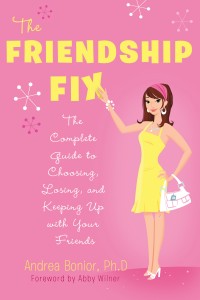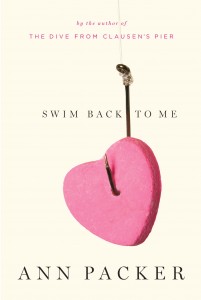 We love our friends. In fact, nothing makes us happier than sharing a glass of wine (or two, or three...) with our favorite girls. One hour with them can melt away any frustration caused by works, kids, husbands, traffic, bad hair days or carb bloat!
That's why we're excited to have Dr. Andrea Bonior sharing her 5 Do's and a Do-Over today! Her new book, The Friendship Fix is all about how to keep your relationships with your besties healthy.
We love our friends. In fact, nothing makes us happier than sharing a glass of wine (or two, or three...) with our favorite girls. One hour with them can melt away any frustration caused by works, kids, husbands, traffic, bad hair days or carb bloat!
That's why we're excited to have Dr. Andrea Bonior sharing her 5 Do's and a Do-Over today! Her new book, The Friendship Fix is all about how to keep your relationships with your besties healthy.
It's also the first pick in BookSparksPR Summer reading challenge-have you signed up yet? What are you waiting for? (hint...The D Word is a pick later this Summer...)
Here's the scoop on The Friendship Fix: Had enough of that bridezilla? Feeling alone in a new city? Dealing with the trauma of the worst breakup ever—with someone you never even made out with?
We’ve heard the path to fulfillment has much to do with relationships. But while it’s often thought that for young women, it's all about finding the right man, real women beg to differ: It's friendships that are at the heart of happiness. Unfortunately, they’re also at the heart of drama, stress, and sometimes not-so-great escapades after that fifth martini. And, technology, from texting to Facebook, has made all friendships more complicated than ever.
At last comes The Friendship Fix, jam-packed with practical ways to improve your life by improving your circle. From dealing with friends-with-benefits to coworkers from the dark side, from feeling alone to being desperate to defriend a few dozen people, Andrea Bonior, Ph.D. helps you make the most of your friendships, whether they be old, new, online, or in person.
Sound fabulous? Then leave a comment to be entered to win one of FIVE copies! We'll choose the winners Sunday June 5th after 6pm PST.
AND...there's an awesome giveaway if you buy a copy! Check it out here! LOTS of cool gift cards(Banana Republic, SpaFinder, etc) and MORE!
CHICK LIT IS NOT DEAD PRESENTS....ANDREA BONIOR'S 5 DO'S AND A DO-OVER
5 DO'S
1. DO take a risk, to connect with someone awesome. In my early days as a Mom, sometimes I’d get to talking with another mother at a playground and we’d connect really well. But when it was time to leave, I’d be terrified to take any next step in keeping things going. In fact, even contemplating it made me feel like some sort of stalker, or the platonic equivalent of the slovenly guy at the bar who winks at everyone with breasts. But as The Friendship Fix lays out, there are ways to take the next step without coming on too strong, though it still requires a leap of faith! Thank goodness I finally learned to stick my neck out when it counted, though, as I now have some wonderful friendships that would never have begun if I hadn’t done so (since they were scared too!).
2. DO step up when you’ve screwed up. For years I’ve been notorious about not hearing my phone. I either don’t notice that it’s switched to silent mode (thank you, poorly-designed iphone cover) or am a victim of the fact that my house’s decent cell service is limited to a shoebox-sized area of our bathtub. Once, I saw a message three weeks after the fact, and it was an old friend needing support. I felt so horrible that I wanted to crawl into a hole and forget the whole thing, and I could only imagine that she had moved on not only from hoping for my help, but from counting on me as a friend as well. I forced myself to own right up to it, though, and to try to make things right, and I’d like to think that we’ve been back on track ever since. As the book discusses, the majority of times that a screwup ends a friendship, it’s the aftermath that does it, not the original mistake. So, face the awkwardness and correct it sooner rather than later. Too often, you might let your embarrassment harden into a polar freeze, and it’s the latter that really ends the friendship.
3. DO follow your instincts when things feel off. Sometimes your gut is dead-on about a friendship that’s not right for you, but often we feel too guilty to heed it. Years ago, my relationship with a person who I really felt I should be compatible with—we had a lot in common, and she was an admirable person— just seemed to have a lot of trouble getting out of first gear. I found myself not that excited about our interactions, and didn’t really feel like my best self around her, despite us spending an increasing amount of time together. Keeping up with her felt like something to be checked off a list rather than something I was drawn to, and I left our outings feeling drained and irritable. Finally, I faced the fact that we just weren’t a good match, and she had a certain edge to her that just rubbed me the wrong way. Though I felt really guilty at first, I backed off the friendship gently—and ended up feeling much freer as a result.
4. DO plan a trip with your closest friends. I just got back from a weekend bachelorette party with some of my dearest college girlfriends, at a cabin so remote that the phrase “Make a left on the third dirt road, past the abandoned van that’s been overgrown by weeds” was actually part of the directions to get there. It was quite a difference from the bachelorette parties of our previous decade (other than the reappearance of a certain prank inflatable item named “Willie”—he’s become an heirloom!). But it couldn’t have been more enjoyable, just being alone together again. Whether it’s a Caribbean cruise or a night at a local hotel, going away with your friends is one of the best things you can do for your relationship. And the anticipation of the trip, plus the recollecting of the memories, give you even more bang for your buck.
5. DO give yourself permission to prioritize your friendships. Life gets busy. Jobs and school and marriage and kids and pets and just general grownup existence—even if all you take care of is a pot of peonies-- can easily take the place of time with friends. It’s so common to feel guilty going to a brunch, for instance, when your daughter has a stomach bug. Or maybe you’ve gotten into a rut of automatically saying no to every happy hour because it’s so much trouble to make alternate arrangements for the evening rush. But you’re a better spouse, coworker, and Mom when you make time for your friends. Prioritizing your friend relationships—which lengthen your lifespan, help ward off depression, and leave you more fulfilled and less stressed—benefits not just you, but everyone in your life as well.
DO-OVER
Do be mindful of casting such a wide net on Facebook. Social networking has obviously revolutionized the way we communicate, and The Friendship Fix discusses in detail many of the pros and cons of its proliferation. One embarrassing example of its shortcomings: it’s easy to get overzealous in your collecting of friends at the expense of actual connecting. A few months after I first got on Facebook, I found myself randomly thinking about an old high school friend of mine—a phenomenal individual who I remembered fondly. I thought about how great it would be to be in touch, how much I wondered what she was up to, how sure I was she was doing something amazing with her life. And then…. I remembered that we were already Facebook friends, and had “reconnected” in the rather superficial, frenzied way that came with the first 200 friend requests when you first join. (“Your kids are gorgeous!” “Your jobs sounds awesome!” “It’s so great to be back in touch!”) I was horrified. Had I been more mindful in my Facebook behavior, I would never have forgotten that reconnection, and would have had a better chance of turning it into an actual emotional reconnection that stood the test of time, rather than that Facebook “friend” that isn’t quite back in my life in the truest sense of the term. There’s room for all levels of friendship in your life, but make sure you’re not fooling yourself about their quality and succumbing to a numbers game.
Thanks Andrea! xoxo, L&L
To read more about Andres, head on over to her website or find her on Facebook and Twitter.



